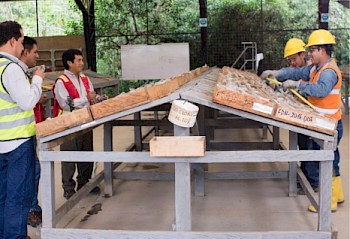Geology and Mineralization



 The structure that hosts the Fruta del Norte deposit is a Jurassic aged pull-apart basin where transtensional movement on a regional scale strike-slip fault has produced a down dropped block approximately 16 km north-south by 2 km east-west. The deposit formed during early basin development along a basin marginal structure at its northeast corner before becoming buried by basin fill sediments. The mineralization is hosted by the underlying Santiago Fm andesites and sediments that comprise an extensive, roughly north-south volcanic arc that was active in eastern Ecuador during the Triassic and Jurassic.
The structure that hosts the Fruta del Norte deposit is a Jurassic aged pull-apart basin where transtensional movement on a regional scale strike-slip fault has produced a down dropped block approximately 16 km north-south by 2 km east-west. The deposit formed during early basin development along a basin marginal structure at its northeast corner before becoming buried by basin fill sediments. The mineralization is hosted by the underlying Santiago Fm andesites and sediments that comprise an extensive, roughly north-south volcanic arc that was active in eastern Ecuador during the Triassic and Jurassic.
Mineralization is characterized by intense, multi-phase quartz–sulphide, with or without carbonate stockwork veining, and brecciation over broad widths. Mineralization is most intense and coherent in the central and northern parts of the system where the gold and silver grades are highest.
Fruta del Norte's mineralogy consists of chalcedonic to crystalline quartz, manganese carbonates, calcite, adularia, barite, marcasite, and pyrite, as well as subordinate sphalerite, galena, chalcopyrite, traces of tetrahedrite and silver sulphosalts. Some of the gold is free milling, however the bulk of the gold is microscopic and associated with quartz, carbonates and sulphides. The mineralization is moderately refractory, with approximately 40% of the gold locked in sulphides. In the higher-grade parts of the system, coarse visible gold is commonly observed with individual gold grains ranging from discrete specks less than 0.1 mm in size to broccoli-like, arborescent crystals more than 10mm across.
